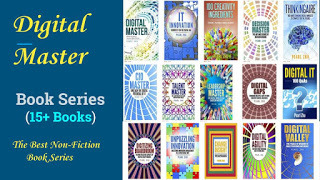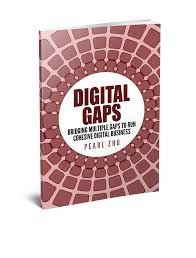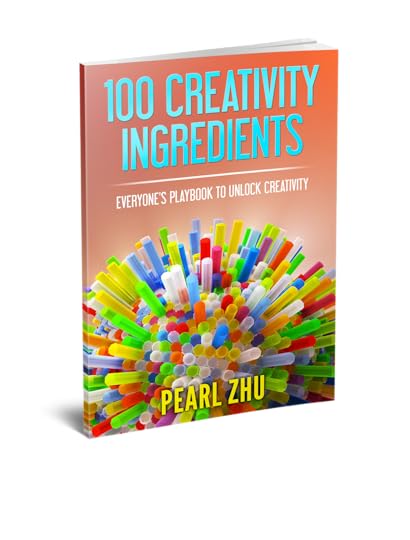Pearl Zhu's Blog, page 1231
May 3, 2017
The Monthly “Change Insight” Book Tuning: The Change Management Maturity May. 2017
 Change is inevitable, organizational change has become a common practice within an organization, but too often changes are made as a reaction to outer impulses, crisis, and demands. This is the bureaucracy’s way of meeting the challenges. A digital transformation is achieved via dynamic Strategy-Execution-Change life cycle management, though it is not all linear steps, but an iterative, ongoing and up going change continuum. How to embed creativity in Change Management and lead change effortlessly? The Change Management Maturity How to Assess and Improve Change Management Maturity? Change is inevitable and needed in every business. But organizational Change Management is always challenging with a high percentage of failure rate. The successful businesses are the ones that have learned how to implement change time after time and build it as a solid ongoing business capability. Change Management requires a well-defined strategy with comprehensive change agenda as well. Is there any ideal route for the change, and how to improve the success rate of Change Management and improve overall Change Management maturity??
Change is inevitable, organizational change has become a common practice within an organization, but too often changes are made as a reaction to outer impulses, crisis, and demands. This is the bureaucracy’s way of meeting the challenges. A digital transformation is achieved via dynamic Strategy-Execution-Change life cycle management, though it is not all linear steps, but an iterative, ongoing and up going change continuum. How to embed creativity in Change Management and lead change effortlessly? The Change Management Maturity How to Assess and Improve Change Management Maturity? Change is inevitable and needed in every business. But organizational Change Management is always challenging with a high percentage of failure rate. The successful businesses are the ones that have learned how to implement change time after time and build it as a solid ongoing business capability. Change Management requires a well-defined strategy with comprehensive change agenda as well. Is there any ideal route for the change, and how to improve the success rate of Change Management and improve overall Change Management maturity??
Five Stages in Change Management? Digital is all about changes, and change is multi-faceted with increasing speed and velocity. So how to manage change effectively? “Change Management” is the overarching umbrella, that encompasses extensive planning, communication, evaluation, creativity, collaboration, measuring outcomes in a shared and trust environment, and being able to declare the end point and successful conclusion. But more specifically, what are the necessary steps in Change Management life Cycle:.
How to Build a CHANGEABLE Organization Riding Above the Learning Curve? Change is inevitable, and the speed of change is increasing. However, organizational change is always difficult. How can you ride above the learning curve, is there any ideal path to change, how to improve the success rate of change management and build change as an ongoing capability of the organization?
How Capable is your Organization Handling Changes? Change becomes fundamentally difficult in most organizations because it is treated as something distinct from running the business, evolving performance and increasing results over time. Leaders and employees are stressed enough in getting done what is right in front of them that change is layered upon becomes disruptive. However, the accelerating speed of change, the volatile and uncertain business environment make the change as an ongoing capability organizations must master, so in which aspects the business should focus on to building its change ‘muscles’?
 Change Management Insight: Five Types of “DNA” to Enforce Organizational Maturity? Change is inevitable, organizational change has become a common practice within an organization, but too often changes are made as a reaction to outer impulses, crisis, and demands. This is the bureaucratic way of meeting the challenges. How to understand the mentalities behind the change as the first step, in order to fine tune the process of Change Management, and overcome the obstacles to managing a digital transformation smoothly?
Change Management Insight: Five Types of “DNA” to Enforce Organizational Maturity? Change is inevitable, organizational change has become a common practice within an organization, but too often changes are made as a reaction to outer impulses, crisis, and demands. This is the bureaucratic way of meeting the challenges. How to understand the mentalities behind the change as the first step, in order to fine tune the process of Change Management, and overcome the obstacles to managing a digital transformation smoothly?Blogging is not about writing, but about thinking; it’s not just about WHAT to say, but about WHY to say, and HOW to say it. It reflects the color and shade of your thought patterns, and it indicates the peaks and curves of your thinking waves. Unlike pure entertainment, quality and professional content takes time for digesting, contemplation and engaging, and therefore, it takes the time to attract the "hungry minds" and the "deep souls." It’s the journey to amplify your voice, deepen your digital footprints, and match your way for human progression.Follow us at: @Pearl_Zhu
Published on May 03, 2017 23:23
What are the “Thinking Blocks” to Build a Mindful Digital Board?
 Corporate board as the top leadership team plays a significant role in business advising, leadership exemplarity, policy setting, and governance practices. BoDs as top decision makers require multidimensional thinking and bring different viewpoints to improve business effectiveness and maturity. So, what are the “thinking blocks” to build a mindful digital board?
Corporate board as the top leadership team plays a significant role in business advising, leadership exemplarity, policy setting, and governance practices. BoDs as top decision makers require multidimensional thinking and bring different viewpoints to improve business effectiveness and maturity. So, what are the “thinking blocks” to build a mindful digital board?
Strategy thinking: The contemporary board oversees business strategy, hence, BoDs need to master of strategy thinking which is the thinking process to “keep the end in mind.” Strategic thinking is more about making decisions directly towards achieving defined outcomes as a purposive activity. Casual strategy leads to superficial results. The BoDs need to gain deeply understanding about the enterprise in order to be a credible actor in the strategy dialogue. Strategic thinking is more analytical, decision-oriented and directional. At the higher level, strategic thinking is about where you are, where you want to be, how to diagnose the key business problems/issues, how to close the gap, set the policies and guidelines, make choices, and including a series of actions.
Systems Thinking: Systems thinking is the thought process to understand the interconnectivity between parts and the whole. Systems thinking look at things by looking at the whole, where the parts are never as important and should always work to benefit the whole. BoDs as directorial roles should leverage Systems Thinking for effective decision-making. Because Systems Thinking as a thinking practice promotes a better strategic awareness; as it encourages looking at the wider aspects around any problem space. In order to operate most effectively, systems thinking should be a part of every step of a strategic process, including strategy oversight. At a high level, system thinking is more often the integral thinking of analytics and synthesis, brings an awareness of an entire system, and how changes to any part of that system impact the other parts of the system and the whole.
 "Independent Thinking": “Independent Thinking” is not just the thinking practice of independent directors. All digital BoDs need to practice to thinking independently. We live in the world with an abundance of information, having the mix of signals and noises, it is important to collective sufficient information, but ultimately make your own mind for making sound judgment and effective decisions. This is particularly important at the board level, because “group thinking,” is one of the biggest pitfalls to compromise the board governance effectiveness. One of the most crucial roles of boards is to practice independent thinking in a certain collective way and provide valuable feedback and deep insight (not rubber stamp) to the management team of the organization and help them improve the management effectiveness and maturity up to the next level.
"Independent Thinking": “Independent Thinking” is not just the thinking practice of independent directors. All digital BoDs need to practice to thinking independently. We live in the world with an abundance of information, having the mix of signals and noises, it is important to collective sufficient information, but ultimately make your own mind for making sound judgment and effective decisions. This is particularly important at the board level, because “group thinking,” is one of the biggest pitfalls to compromise the board governance effectiveness. One of the most crucial roles of boards is to practice independent thinking in a certain collective way and provide valuable feedback and deep insight (not rubber stamp) to the management team of the organization and help them improve the management effectiveness and maturity up to the next level.
The digital enterprise consists of an amalgam of socio-systems, techno-systems, bio-systems, and Econo-systems. BoDs as the top business advisor role need to build the solid thinking blocks and have sufficient knowledge to understand the business ecosystem and sense that the digital transformation is multifaceted. They need to become mindful, insightful, innovative and decisive.
Follow us at: @Pearl_Zhu
Published on May 03, 2017 23:19
Transactional vs. Transformational Digital Competency
 Forward-looking organizations are on the journey of digital transformation, to become more nimble, innovative and customer centric and achieve a high-performance business result. Businesses have to build the healthy digital capability portfolio with the transactional capabilities to “keep the lights on,” and the transformative capabilities to lift the organization to the upper level of maturity. The cohesive set of business capabilities is built into the digital competency of the organization.
Forward-looking organizations are on the journey of digital transformation, to become more nimble, innovative and customer centric and achieve a high-performance business result. Businesses have to build the healthy digital capability portfolio with the transactional capabilities to “keep the lights on,” and the transformative capabilities to lift the organization to the upper level of maturity. The cohesive set of business capabilities is built into the digital competency of the organization.
Transactional vs. Transformational competency: The transactional business capabilities are usually operation driven, to keep the lights on and improve business efficiency. Where transactional or operational capability makes only minor adjustments in the organization’s, structure, and management, etc., it often takes the linear step for tuning the enterprise machine and ensure it keeps spinning. On the other hand, the transformational capability can often make of leap of business changes, they also evoke fundamental evolutions in the basic political and cultural systems of the organization. Transformational capability creates something new out of something old, reach the new horizon out of an old vision. Transaction-driven operational management may be viewing things from a single side (internally) and transformation-driven strategic management takes a holistic view of things (both internally and externally) as the way of coming up with actions that will improve organizational performance and conformance in order to achieve the set goals. In the digital era, we will be confronting a number of high-complex problems in the hyper-connected world, the business solutions will require integration of different sets of knowledge and fluency across multiple disciplines. Often the transformational capability is the ability to work across disciplines to solve complex problems with contextual understanding. It helps to expand the organization’s horizon and lift the business up to the next level of maturity.
Competitive necessity vs. competitive uniqueness: Organizations need to have two sets of competency, the necessary competency to run the business as others do and reap some quick wins; also the unique competency to stand out and build the long term business advantage as well as a strong business brand. Competitive necessity focuses on meeting the customer expectation and deliver what the business asks for; while competitive uniqueness allows the business to “dream bigger,” and achieve the art of possible - it involves new ways of bringing together ideas and resources to create something novel, figure out “the best or most innovative solution" for the business' requirement, offering added value and feature insights based on system understanding. Competitive necessity is the “me too” feature, to keep the bottom line; but competitive uniqueness makes you shine even at the raining day. It provides the opportunity to think the new way to do things; it helps the business to differentiate itself from competitors. The differentiation provided by differentiated capabilities usually is more long-lived than differentiation provided by marketing actions that can be copied easier. Hence, a clear understanding what capabilities, services or solutions are supporting your competitive advantage is needed in order to build unique competency.
 Reactive vs. proactive change capability: The digital capability maturity depends on how the business manages changes (reactive vs. proactive mode). Transactional management reacts to the business changes, while transformational management takes initiatives to drive changes proactively. Digital means increasing the speed of change and continuous disruption. How successful the organization can handle digital disruption depends on how fast and capable they can adapt to the ever-changing environment. Hence, proactive change capability will differentiate the digital masters from laggards. Due to the increasing speed of changes, organizations need to pay more attention in creating shared and admirable goals and then encourage the teams to compete and collaborate as they deem fit. Digital organizations need to be self-adaptive to the dynamic environment, and those highly adaptive enterprises can succeed in combining two distinct but interconnected elements, strategic responsiveness, and organizational flexibility, with the combination of an innovative culture that promotes responsiveness throughout the company and builds the transformative digital competency across the digital ecosystem.
Reactive vs. proactive change capability: The digital capability maturity depends on how the business manages changes (reactive vs. proactive mode). Transactional management reacts to the business changes, while transformational management takes initiatives to drive changes proactively. Digital means increasing the speed of change and continuous disruption. How successful the organization can handle digital disruption depends on how fast and capable they can adapt to the ever-changing environment. Hence, proactive change capability will differentiate the digital masters from laggards. Due to the increasing speed of changes, organizations need to pay more attention in creating shared and admirable goals and then encourage the teams to compete and collaborate as they deem fit. Digital organizations need to be self-adaptive to the dynamic environment, and those highly adaptive enterprises can succeed in combining two distinct but interconnected elements, strategic responsiveness, and organizational flexibility, with the combination of an innovative culture that promotes responsiveness throughout the company and builds the transformative digital competency across the digital ecosystem.
Digital organizations today have to strike the right balance of being transactional to keep spinning and being transformational to make a leap. The organizational management shortsightedness and running the business in a transactional mode only can cause digital ineffectiveness for the long run. The competitive necessity and competitive uniqueness are both important, the maturity of a business capability would be based on the ability to deliver on either customer needs or to achieve the desired capability outcome, but also importantly, to build the differentiated brand and the long-term competency.
Follow us at: @Pearl_Zhu
Published on May 03, 2017 23:14
May 2, 2017
The Popular Quotes Collection XIV of “Digital Master” Book Series
 “Digital Master” is the series of guidebooks (15+ books) with five pillars to perceive the multifaceted impact digital is making to the business and our society, help forward-thinking organizations navigate through the digital journey in a systematic way, and avoid “rogue digital.” Here is the set of popular quotes for conveying the digital vision and sharing the unique insight about the digital transformation.
“Digital Master” is the series of guidebooks (15+ books) with five pillars to perceive the multifaceted impact digital is making to the business and our society, help forward-thinking organizations navigate through the digital journey in a systematic way, and avoid “rogue digital.” Here is the set of popular quotes for conveying the digital vision and sharing the unique insight about the digital transformation.
 Digital Gaps: Bridging Multiple Gaps to Run Cohesive Digital Business
Digital Gaps: Bridging Multiple Gaps to Run Cohesive Digital Business
“With increasing rate of changes, the organization needs to be adapted in such a way that it can respond effectively to the dynamic changes and to the variety in the environment.” ― Pearl Zhu, Digital Gaps: Bridging Multiple Gaps to Run Cohesive Digital Business
“Human’s mind is the most valuable thing to shape every progress, but also the root cause of all mankind problems.” ― Pearl Zhu, Digital Gaps: Bridging Multiple Gaps to Run Cohesive Digital Business
“The simplicity and the complexity are just the opposite ends of the same spectrum.” ― Pearl Zhu, Digital Gaps: Bridging Multiple Gaps to Run Cohesive Digital Business
“The depth of perspective and strength of character are what make thinking profound.” ― Pearl Zhu, Digital Gaps: Bridging Multiple Gaps to Run Cohesive Digital Business
“Perception is the way one’s eyes see the surrounds and one’s mind interprets it.” ― Pearl Zhu, Digital Gaps: Bridging Multiple Gaps to Run Cohesive Digital Business
 Decision Master: The Art and Science of Decision Making by Pearl Zhu
Decision Master: The Art and Science of Decision Making by Pearl Zhu
“The art of decision making includes the art of questioning.” ― Pearl Zhu, Decision Master: The Art and Science of Decision Making
“The science of decision-making is to make sure there is an effective decision process in place.” ― Pearl Zhu, Decision Master: The Art and Science of Decision Making
“Both the art of intuition and the science of analytics have the role to play in making wise decisions.” ― Pearl Zhu, Decision Master: The Art and Science of Decision Making
“Decision maturity is to ensure the right decisions have been made by the right people at the right time to solve the right problems.” ― Pearl Zhu, Decision Master: The Art and Science of Decision Making
“The company’s leadership plays a major role in framing the right questions for decision-making.” ― Pearl Zhu, Decision Master: The Art and Science of Decision Making
 100 Creativity Ingredients: Everyone’s Playbook to Unlock Creativity by Pearl ZhuThe collective sensation is one’s perspective, experience, memory, imagination, and perception.65 Pattern understanding is the type of problem-solving thinking.― Pearl Zhu, 100 Creativity Ingredients: Everyone’s Playbook to Unlock Creativity by Pearl Zhu
100 Creativity Ingredients: Everyone’s Playbook to Unlock Creativity by Pearl ZhuThe collective sensation is one’s perspective, experience, memory, imagination, and perception.65 Pattern understanding is the type of problem-solving thinking.― Pearl Zhu, 100 Creativity Ingredients: Everyone’s Playbook to Unlock Creativity by Pearl Zhu
Innovations succeed when failure is seen as a learning step to great success.-100 Creativity Ingredients: Everyone’s Playbook to Unlock Creativity by Pearl Zhu
A multi-linguistic mindset is multi-faceted to think from a different angle. -100 Creativity Ingredients: Everyone’s Playbook to Unlock Creativity by Pearl Zhu
While the individual contributions provide the “building block” of creativity; it is the collective consensus on what to do with them that is exciting. -100 Creativity Ingredients: Everyone’s Playbook to Unlock Creativity by Pearl Zhu
Digital professional with accelerated mind continue to learn and develop creativity and recombinant professional capability.-100 Creativity Ingredients: Everyone’s Playbook to Unlock Creativity by Pearl Zhu
Follow us at: @Pearl_Zhu
Published on May 02, 2017 23:37
The Digital Board’s Digital Inquiries
 Digitalization is driving unpredictability demanding a more rapid deployment that quickly can adapt to the changes and adjust to the new market conditions. Hence, digital strategy management takes nonlinear steps and embrace the emergent events and activities. Digital strategy making and execution are a collective effort of varying business departments to fit business purposes, leverage digital speed, and delight customers. Digital boards as the strategic advising role are also the “master mind” behind digital transformation to oversee strategy and monitor performance. Here are a couple of digital board’s digital inquiries.
Digitalization is driving unpredictability demanding a more rapid deployment that quickly can adapt to the changes and adjust to the new market conditions. Hence, digital strategy management takes nonlinear steps and embrace the emergent events and activities. Digital strategy making and execution are a collective effort of varying business departments to fit business purposes, leverage digital speed, and delight customers. Digital boards as the strategic advising role are also the “master mind” behind digital transformation to oversee strategy and monitor performance. Here are a couple of digital board’s digital inquiries.
Do organizations have a digital strategy? Do existing functions and business units have a game plan for Digital transformation? Digital strategy is the process of specifying an organization's vision, goals, opportunities, and initiatives in order to maximize the business benefits of digital initiatives to the organization. Enabling technologies for digital strategy are everything from online platform to social media, knowledge base tools, mobile, etc. These can range from an enterprise focus, which considers the broader opportunities and risks that digital technologies potentially creates changes and often includes customer intelligence, collaboration, new product/market exploration, sales and service optimization, enterprise technology architectures and processes, innovation and governance; to more marketing and customer-focused efforts. Every functional unit should have their own sub-strategies which are components of the cohesive digital strategy of the company. A good strategy should identify the business challenges, make options, and take stepwise actions based on a clear roadmap to achieve the well-defined business goals.
How to make good assumptions for digital strategy making? Digital has the “VUCA” characteristics - velocity, uncertainty, complexity, and ambiguity. It implies both business opportunities and risks on the way. As far as for assumptions, sometimes it’s inevitable that you have to make them, because you will never have complete information, and if you try to only act on what you know by fact, you are more likely to go wrong or lag behind. Also, when trying to determine the macro digital environment, and how the factors there may influence your business strategic plan one way or another, it is difficult to move away entirely from assumptions. But it is still important to set digital principles for making better assumptions for strategy making. So you have to collect enough information, listen to different PoVs, as everything has more than one side and you have to master them all. And sometimes it can be very worthwhile to spend extra time to solve a problem excellently. You can perhaps discover an insight you didn't find before; or you could find a clearer way to think about the problem, which you can reuse next time. It is important to leverage systems thinking for understanding the interconnectivity of the digital ecosystem and gaining the business insight.
Who owns Digital? Who owns which elements of digital strategy? Digital strategy should look holistically at the business and how digital technology will impact and lead transformation in all the business needs such as internal communication, supply pipeline, customer communication). Senior executive teams should take co-responsibility of crafting and executing corporate digital strategy, and they could be the “owner of digital strategy.” And each functional leader own their piece of sub-strategies, but they have to work collaboratively to ensure a cohesive strategy development and a seamless digital strategy execution. The digital strategy is not bound by one functional area (such as IT), but rather included the whole organization with a mission to increase customer experience and engagement, and hence increased market shares and revenue.A good digital business strategy answers questions like (1) Can and how digital optimize the business model or engagement model? (2) How does digital impact different business practices (sales/marketing, hr, production)? (3) How to enable digital platforms with mechanisms to ensure cross-functional communication and collaboration? 4) In terms of KPIs - Increase in sales, decrease in marketing and HR costs, optimized production, etc.
Which digital impacts have you identified? Which functions are the most impacted by Digital? The digital makes impact on every dimension of the business, from information management to strategy management; from products/service/business model to customer relationship management and performance management. In practice, even in the simplest organizations, the industrial 'speed' is not homogenous across the enterprise. There are differences between 'front office' and 'back office'; enterprises with multiples businesses and associated business models. Different functions evolve digital with different speed. So, many organizations will have to 'mix and match' at least two different Industrial 'Speeds' with appropriate governance styles, accommodating the result in different steps of digital strategy cycles. to break down silos and ensure the business as a whole more optimal than the sum of the piece. But in all such relationships, the digital leaders need to have a very good grasp of the overall business, its strategy, marketplace, business model and competitive distinctiveness to ensure that the business solutions supplied to the enterprise deliver maximum value at acceptable cost with optimum services/solutions
 What is the talent gap when it comes to defining and executing the enterprise-level digital strategy? People are still the weakest link in digital transformation. The studies show that the majority of people are not engaged in their jobs because their talent is not being utilized; or organizations fail to put the right people with the right capability to solve the right problem. People are the most invaluable asset in businesses, at the age of digital, it is, even more, true than ever. Talent employees are treated as human capital needs to be well invested to unleash the boundless potential, not just human resources counted as a cost. Organizations should both develop the updated digital practice to manage performance as well as digital methodology to unleash potential. The top team has significant influence on implementing Performance Management into practice in the digital way. The platinum rule - asking others how they wish to be treated. This means open communication. Asking others how they work best. What makes them tick. Treat people with courtesy, respect, and empathy. Hyperconnectivity is one of the great characteristics of digital transformation. Organizations and their people learn through their interactions with the environment. It is the responsibility of the leaders to initiate his or her team to break the silos to realize the common goals or strategy which are far more important than the personal and departmental goals.
What is the talent gap when it comes to defining and executing the enterprise-level digital strategy? People are still the weakest link in digital transformation. The studies show that the majority of people are not engaged in their jobs because their talent is not being utilized; or organizations fail to put the right people with the right capability to solve the right problem. People are the most invaluable asset in businesses, at the age of digital, it is, even more, true than ever. Talent employees are treated as human capital needs to be well invested to unleash the boundless potential, not just human resources counted as a cost. Organizations should both develop the updated digital practice to manage performance as well as digital methodology to unleash potential. The top team has significant influence on implementing Performance Management into practice in the digital way. The platinum rule - asking others how they wish to be treated. This means open communication. Asking others how they work best. What makes them tick. Treat people with courtesy, respect, and empathy. Hyperconnectivity is one of the great characteristics of digital transformation. Organizations and their people learn through their interactions with the environment. It is the responsibility of the leaders to initiate his or her team to break the silos to realize the common goals or strategy which are far more important than the personal and departmental goals. Digital boards are like the steer wheel of their company, leading business toward the uncharted water for reaching the digital destination. Although you can not predict every event happening on the journey, surely you need to proactively create a clear vision, make a good strategy, and execute it via an iterative continuum, and create a business - talent synergy to accelerate the digital transformation and reap the business benefit both via quick win and long term perspectives. Follow us at: @Pearl_Zhu
Published on May 02, 2017 23:35
CIOs as “Chief Influence Officer” with Multidimensional Influence
 Tradition CIOs have been perceived as the tactical IT managers, running as IT as a support function to keep the lights on. Nowadays, with fast-paced changes and overwhelming growth of information, contemporary CIOs face many leadership dilemmas: being sustainable or disrupt, keep status quo or innovative? Act as a business executive or an IT manager., etc. The command-control leadership style is no longer fit for the hyperconnected and highly transparent digital new normal. Digital CIOs today must develop their leadership capabilities to make multidimensional influence across the organization as well as the digital ecosystem.
Tradition CIOs have been perceived as the tactical IT managers, running as IT as a support function to keep the lights on. Nowadays, with fast-paced changes and overwhelming growth of information, contemporary CIOs face many leadership dilemmas: being sustainable or disrupt, keep status quo or innovative? Act as a business executive or an IT manager., etc. The command-control leadership style is no longer fit for the hyperconnected and highly transparent digital new normal. Digital CIOs today must develop their leadership capabilities to make multidimensional influence across the organization as well as the digital ecosystem.
Leadership influence: Today’s digital CIO is the top leadership role, and leadership is about future and direction. Hence, the skills CIOs should exercise including technology vision, strategy making and execution, innovation, etc. Digital corporations are massive, complex dynamic ecosystems, nowadays, CIO and other CXOs should stand side by side with the goals of creating new and innovative products, transforming IT into a profit center and integrate IT across all business units. What determines the maturity level of the CIO position is the impact they have made on others, and hence, their reputation as well as achievements. An effective CIO needs to be an independent thinker, unbiased communicator, flexible doer and global leader these days. Gone are the days where the CIO is given a target and a budget and he/she executes. The effective CIOs should have excellent working relationships with other business leaders. Digital savvy CIOs can also identify the formal and informal power brokers cross the boundary and establish a personal dialogue with them to identify the real problems prior to presenting the IT enabled business solutions. CIOs who have developed influential competence seek to understand the mindset of all related parties, it takes open leadership, humble attitude, and a fact-driven communication, mixing candor with openness, balancing humility and courage.
Position Influence: Although leadership goes beyond just a title or a position, empowered CIOs who have the seat at the big table and have the voice in strategy setting can amplify their leadership influence: Do they sit at the big table (the board). Are they part of the core operating committee of the company? What has there been progression within the company? Span of Control: What’s the total team and number of direct reports. That would indicate the position-based leadership influence. The continuous technology evolution means CIOs should be empowered to lead changes, drive digital transformation proactively, bridge the IT and business gaps, and delegate others within their team responsible for managing business as usual and make continuous technical deliverable. IT is the steward of the business information system. The position influence of CIO can also help to break down the functional silos, overcome the office politics, streamline digital flow and maximize the digital potential of the entire company.
 Expert/Social Influence: CIO is perhaps one of the most sophisticated leadership role in the modern business. Your title can provide you some authority to facilitate, but can't guarantee your leadership effectiveness. Knowledge is power. Digital CIOs today need to be learning agile as knowledge life cycle is significantly shortened, and technology is often the disruptive force of digital transformation. The expert power can make leadership influence more profound and empathetic, to connect the minds and improve leadership effectiveness. Now more often the business is inextricably connected with technology, and the functional barriers are starting to weaken, allowing digital leaders and professionals to pursue their aspirations and to apply their skills and expertise to their greatest effect. Thus, digital leaders and professionals need to strengthen their strength and build a unique portfolio of competency and capabilities, and practice expert power based on the foundation of in-depth knowledge, profound insight, and abstract wisdom. Expert power is neither equal to the title you have or the certificate you hold. your education certificate can imply you have a certain level of learning ability, but can't guarantee you still have updated knowledge and you can co-create new knowledge and develop unique leadership competency, be the true leader to make the splash, not just the follower to chase the waves.
Expert/Social Influence: CIO is perhaps one of the most sophisticated leadership role in the modern business. Your title can provide you some authority to facilitate, but can't guarantee your leadership effectiveness. Knowledge is power. Digital CIOs today need to be learning agile as knowledge life cycle is significantly shortened, and technology is often the disruptive force of digital transformation. The expert power can make leadership influence more profound and empathetic, to connect the minds and improve leadership effectiveness. Now more often the business is inextricably connected with technology, and the functional barriers are starting to weaken, allowing digital leaders and professionals to pursue their aspirations and to apply their skills and expertise to their greatest effect. Thus, digital leaders and professionals need to strengthen their strength and build a unique portfolio of competency and capabilities, and practice expert power based on the foundation of in-depth knowledge, profound insight, and abstract wisdom. Expert power is neither equal to the title you have or the certificate you hold. your education certificate can imply you have a certain level of learning ability, but can't guarantee you still have updated knowledge and you can co-create new knowledge and develop unique leadership competency, be the true leader to make the splash, not just the follower to chase the waves.
Leadership is an influence. CIOs and IT do need to play critical roles in the digital transformation. As more often than not, technology is the major digital disruptor today. The multidimensional influence of CIOs can be well articulated by the “I” of the CIO title - Information, insight, intelligence, improvement, inspiration, and innovation, etc. High mature CIOs are high influencers through their breadth of business knowledge and the depth of IT insight. An digital CIO has to be a digital visionary, a transformational leader, an empathetic communicator, a good facilitator, a great listener, and a digital game changer.
Follow us at: @Pearl_Zhu
Published on May 02, 2017 23:31
May 1, 2017
The Monthly Digital CIO Spotlight: CIO as Chief Innovation Officer May 2017
Modern CIOs have many personas and face great challenges.
 Modern CIOs have many personas and face great challenges. It is not sufficient to only keep the light on. Regardless of which industry or the nature of organization you are in, being a digital leader will need to master the art of creating unique, differentiating value from piles of commoditized technologies, but more specifically, CIOs as "Chief Innovation Officer, how to run IT as a growth engine and innovation Hub? Here is the monthly spotlight of the CIO.
Modern CIOs have many personas and face great challenges. It is not sufficient to only keep the light on. Regardless of which industry or the nature of organization you are in, being a digital leader will need to master the art of creating unique, differentiating value from piles of commoditized technologies, but more specifically, CIOs as "Chief Innovation Officer, how to run IT as a growth engine and innovation Hub? Here is the monthly spotlight of the CIO.
CIO as Chief Innovation Officer
CIOs as Chief Innovation Officer: Can you Clarify the Business’s Expectation from IT via Innovation Lens? As businesses embark on the “Digital Era” of computing and managing, with the changing nature of information & technology, IT is always in the changing environment creating unexpected situations and requiring quick and appropriate responses based on the conditions. IT has to change with the faster speed and also drive the business transformation practively. The nature of the digital IT leadership needs to focus on information and innovation, and the primary role of the CIO needs to become the "Chief Innovation Officer," to not just running IT as a support center, but as the innovation engine to catalyze business growth and build the organization’s differentiated competency and long-term winning advantage.CIOs as “Chief Intrapreneur Officer”: Practicing Entrepreneurship in IT Contemporary CIOs have multiple personas, "Chief Innovation Officer," and “Chief Intrapreneur Officers,” are the most pertinent titles for CIOs to fit the digital leadership role in running IT as a business. Companies are recognizing that IT is roughly coupled to the business strategy as an innovation engine. With increasing pace of changes, CIOs generally have greater opportunities to stand out and practice digital leadership in driving innovation across their companies. Being entrepreneurial is first the mindset, then an attitude and skills are the easier part to be developed. More and more forward-looking IT organizations are practicing entrepreneurship and running IT as a software startup to play the niche and make continuous deliveries.CIOs as “Chief Idea & Innovation Officer”: Five Principles for Idea Evaluation and Management Innovation is the only way businesses can build differentiated advantages in face of fierce competitions in the digital era. From the business perspective, innovation is the mechanism through which you grow and evolve something to something great - higher value-add or ever breakthrough, or something new or better based on a combination or modification of previous attributes/approaches. Innovations can range from small to game changers. Also, it is important to note that within the organizations, innovation is rarely an individual action; rather it is a team effort, often across multiple organizational silos. More often than not, IT is the disruptive force of digital innovation, CIOs as “Chief Idea & Innovation Officer” - How should you set principles for evaluating and managing ideas effectively?
CIOs as Chief Innovation Officer: Can you Play the Role at the Big Table More and more organizations invite their CIOs to the big table for strategic discussions. The issue is that there are too many examples that CIOs (or other senior IT executives) have a "seat at the table," participate the conversations with non-IT executive decision makers, but they are often not given the "appropriate voice" in getting engaged in discussions, focused on the quest to leverage IT initiatives. So what are some effective ways to get to the point where IT is considered a driver as well as an enabler? CIOs, though you have a seat at the table, do you play the role and have the voice over the table? Formal meetings with individual stakeholders are essential, so are informal meetings. What should they focus on? How should they differ from Board meetings or governance meetings?
 CIOs as Chief Intrapreneur Officer: How to Encourage Creativity and Manage Innovation? It's common that many IT companies tend to focus more on their core competencies with age and often forget about the value of innovation. Without encouraging creativity, organizations would be upstaged by the ones that are creative because disruptive innovation will happen no matter how well you prepare. Digital IT needs to be run as a business, and digital CIOs should be the “Chief Intrapreneur Officer,” with “whole brain” thinking: Being logic in your mind based on your years of engineering training and experiences and be creative in your heart, dream big and think big. Because the CIO’s vision will directly impact their organization’s strategic perspective for the long term. So, how to encourage creativity and manage innovation effectively?
CIOs as Chief Intrapreneur Officer: How to Encourage Creativity and Manage Innovation? It's common that many IT companies tend to focus more on their core competencies with age and often forget about the value of innovation. Without encouraging creativity, organizations would be upstaged by the ones that are creative because disruptive innovation will happen no matter how well you prepare. Digital IT needs to be run as a business, and digital CIOs should be the “Chief Intrapreneur Officer,” with “whole brain” thinking: Being logic in your mind based on your years of engineering training and experiences and be creative in your heart, dream big and think big. Because the CIO’s vision will directly impact their organization’s strategic perspective for the long term. So, how to encourage creativity and manage innovation effectively?
The “Future of CIO” Blog has reached 1.8 million page views with about #3600th blog posting in 59+ different categories of leadership, management, strategy, digitalization, change/talent, etc. The content richness is not for its own sake, but to convey the vision and share the wisdom. Blogging is not about writing, but about thinking and innovating the new ideas; it’s not just about WHAT to say, but about WHY to say, and HOW to say it. It reflects the color and shade of your thought patterns, and it indicates the peaks and curves of your thinking waves. Unlike pure entertainment, quality and professional content takes time for digesting, contemplation and engaging, and therefore, it takes the time to attract the "hungry minds" and the "deep souls." It’s the journey to amplify diverse voices and deepen digital footprints, and it's the way to harness your innovative spirit.Follow us at: @Pearl_Zhu
 Modern CIOs have many personas and face great challenges. It is not sufficient to only keep the light on. Regardless of which industry or the nature of organization you are in, being a digital leader will need to master the art of creating unique, differentiating value from piles of commoditized technologies, but more specifically, CIOs as "Chief Innovation Officer, how to run IT as a growth engine and innovation Hub? Here is the monthly spotlight of the CIO.
Modern CIOs have many personas and face great challenges. It is not sufficient to only keep the light on. Regardless of which industry or the nature of organization you are in, being a digital leader will need to master the art of creating unique, differentiating value from piles of commoditized technologies, but more specifically, CIOs as "Chief Innovation Officer, how to run IT as a growth engine and innovation Hub? Here is the monthly spotlight of the CIO. CIO as Chief Innovation Officer
CIOs as Chief Innovation Officer: Can you Clarify the Business’s Expectation from IT via Innovation Lens? As businesses embark on the “Digital Era” of computing and managing, with the changing nature of information & technology, IT is always in the changing environment creating unexpected situations and requiring quick and appropriate responses based on the conditions. IT has to change with the faster speed and also drive the business transformation practively. The nature of the digital IT leadership needs to focus on information and innovation, and the primary role of the CIO needs to become the "Chief Innovation Officer," to not just running IT as a support center, but as the innovation engine to catalyze business growth and build the organization’s differentiated competency and long-term winning advantage.CIOs as “Chief Intrapreneur Officer”: Practicing Entrepreneurship in IT Contemporary CIOs have multiple personas, "Chief Innovation Officer," and “Chief Intrapreneur Officers,” are the most pertinent titles for CIOs to fit the digital leadership role in running IT as a business. Companies are recognizing that IT is roughly coupled to the business strategy as an innovation engine. With increasing pace of changes, CIOs generally have greater opportunities to stand out and practice digital leadership in driving innovation across their companies. Being entrepreneurial is first the mindset, then an attitude and skills are the easier part to be developed. More and more forward-looking IT organizations are practicing entrepreneurship and running IT as a software startup to play the niche and make continuous deliveries.CIOs as “Chief Idea & Innovation Officer”: Five Principles for Idea Evaluation and Management Innovation is the only way businesses can build differentiated advantages in face of fierce competitions in the digital era. From the business perspective, innovation is the mechanism through which you grow and evolve something to something great - higher value-add or ever breakthrough, or something new or better based on a combination or modification of previous attributes/approaches. Innovations can range from small to game changers. Also, it is important to note that within the organizations, innovation is rarely an individual action; rather it is a team effort, often across multiple organizational silos. More often than not, IT is the disruptive force of digital innovation, CIOs as “Chief Idea & Innovation Officer” - How should you set principles for evaluating and managing ideas effectively?
CIOs as Chief Innovation Officer: Can you Play the Role at the Big Table More and more organizations invite their CIOs to the big table for strategic discussions. The issue is that there are too many examples that CIOs (or other senior IT executives) have a "seat at the table," participate the conversations with non-IT executive decision makers, but they are often not given the "appropriate voice" in getting engaged in discussions, focused on the quest to leverage IT initiatives. So what are some effective ways to get to the point where IT is considered a driver as well as an enabler? CIOs, though you have a seat at the table, do you play the role and have the voice over the table? Formal meetings with individual stakeholders are essential, so are informal meetings. What should they focus on? How should they differ from Board meetings or governance meetings?
 CIOs as Chief Intrapreneur Officer: How to Encourage Creativity and Manage Innovation? It's common that many IT companies tend to focus more on their core competencies with age and often forget about the value of innovation. Without encouraging creativity, organizations would be upstaged by the ones that are creative because disruptive innovation will happen no matter how well you prepare. Digital IT needs to be run as a business, and digital CIOs should be the “Chief Intrapreneur Officer,” with “whole brain” thinking: Being logic in your mind based on your years of engineering training and experiences and be creative in your heart, dream big and think big. Because the CIO’s vision will directly impact their organization’s strategic perspective for the long term. So, how to encourage creativity and manage innovation effectively?
CIOs as Chief Intrapreneur Officer: How to Encourage Creativity and Manage Innovation? It's common that many IT companies tend to focus more on their core competencies with age and often forget about the value of innovation. Without encouraging creativity, organizations would be upstaged by the ones that are creative because disruptive innovation will happen no matter how well you prepare. Digital IT needs to be run as a business, and digital CIOs should be the “Chief Intrapreneur Officer,” with “whole brain” thinking: Being logic in your mind based on your years of engineering training and experiences and be creative in your heart, dream big and think big. Because the CIO’s vision will directly impact their organization’s strategic perspective for the long term. So, how to encourage creativity and manage innovation effectively?The “Future of CIO” Blog has reached 1.8 million page views with about #3600th blog posting in 59+ different categories of leadership, management, strategy, digitalization, change/talent, etc. The content richness is not for its own sake, but to convey the vision and share the wisdom. Blogging is not about writing, but about thinking and innovating the new ideas; it’s not just about WHAT to say, but about WHY to say, and HOW to say it. It reflects the color and shade of your thought patterns, and it indicates the peaks and curves of your thinking waves. Unlike pure entertainment, quality and professional content takes time for digesting, contemplation and engaging, and therefore, it takes the time to attract the "hungry minds" and the "deep souls." It’s the journey to amplify diverse voices and deepen digital footprints, and it's the way to harness your innovative spirit.Follow us at: @Pearl_Zhu
Published on May 01, 2017 22:39
Strengthen The Weakest Link in Digital Transformation
 Digital transformation is reshaping our thinking and recasting the way we view ourselves, the digital ecosystem of which we are the part of the environments in which we live, and the way we think and solve problems. Either business or the world is transforming from siloed functions, the sum of pieces into a connected whole. Hyper-connectivity is the most critical digital characteristics. Hence, it is important to understand that digital business development is a multifaceted and holistic management discipline. It is the paradigm shift which takes a multidisciplinary approach. In practice, how to identify and strengthen the weakest links in order to drive the digital transformation seamlessly.
Digital transformation is reshaping our thinking and recasting the way we view ourselves, the digital ecosystem of which we are the part of the environments in which we live, and the way we think and solve problems. Either business or the world is transforming from siloed functions, the sum of pieces into a connected whole. Hyper-connectivity is the most critical digital characteristics. Hence, it is important to understand that digital business development is a multifaceted and holistic management discipline. It is the paradigm shift which takes a multidisciplinary approach. In practice, how to identify and strengthen the weakest links in order to drive the digital transformation seamlessly. Murky vision: Due to the digital “VUCA” normality, organizations are stepping into the uncharted water and get cross the blurred territories toward the business transformation. Without a clear vision, it could be easy to get lost, distracted, and lag behind. The digital business is very complex, the leaders need to observe, perceive, and pay attention to the myriad of internal, external, national or global forces that define and influence the way we do business these days. It is true that the digital leaders must have a clear vision, which is not clouded or distorted either by rosy colored glasses or overly narrow lens. It is the vision established based on realistic expectation, but also high enough that inspire people to excel and challenge the organization to thrive. The vision thing is not just about the simply “seeing,” it is the perception about the future; some visions are tunnel-like, other visions are short-sighted, but the best digital vision should be circular and attainable. Digital transformation is more as the journey, not just a destination, hence, the digital vision shouldn't be a fixed target, it should be stable enough to make it worthwhile to make a concerted effort to attain it and dynamic enough to be able to react to any change in business direction or context.
Comfort zone: Digital is the age of people, people are often the cause of change, often the weakest link of digital transformation as well. When people get stuck in their comfort zone, they slow down the digital flow and stifle the innovation. Some say people don’t fear change, they fear being changed. People only like the comfort zone if they have been given no reason to consider going someplace better or don't even know there is a "new and improved" zone they could go to or the progress they could make. The risk is the potential of losing something weighed against the potential of gaining something. If change is going to make them feel more comfortable, they accept it. If not, they resist. The perception/ response to consequences vary from person to person, and that's what makes change interesting and challenging. The more complex the change, the more complex the solution, the more important to practice effective change leadership for providing a combination approach for riding above the learning curve as well as solving immediate problems with a sense of urgency.
Lag time: Digital means the fast pace of change, velocity, complexity and uncertainty, the exponential growth of information and continuous technology disruption. That could be an opportunity enabling to foresee possibilities and probabilities that might crop in our way of progress. As we all know the only "certainty" or a "constant" is "CHANGE." Business is only an extended part of our life and all businesses have to accept change to survive. Timing is, therefore, critical, because when you miss the right timing, you miss the opportunity; and if you don’t move fast enough, you already lag behind. From the business management perspective, it means to have the right people getting the right information to make the right decisions TIMELY. Optimal decision-making mechanisms ensure decisions occur as fast as they possibly can, with the speed being in perfect balance with cost and risk for the given decision situation. So, the business can catch up the speed of business change, make real-time business or customer insight, adjust the strategic goals, and make strategy execution not as linear steps, but as the digital continuum.
Rigid process: Digital businesses are in fact complex, but it doesn’t mean you should make things more complicated; on the opposite, simplification is an optimal stage to run a high mature digital organization. Many times, people in organization follow processes mindlessly, at times just because it becomes a need. Overly rigid processes or bureaucratic structure setting enforce silos and disturb the digital flow, and hence, deaccelerate digital transformation. It is important to manage a clear set of objectives, planning, communication, and training goes into a proper system or process implementation. The elements of strategy can be used to guide and evaluate the development of business processes. In that way, you get independent checks and balances for the overall business solution you are trying to develop. To optimize underlying business process and functions, do transformations, process automation, implementation and monitoring which will eventually enhance and improve the organization’s efficiency; which would increase its productivity and profit in the market. It also helps in reduction of time to market, improved customer satisfaction, achieved cost efficiency and maximize revenue.
 Cognition and skills gap: There are still multiple gaps existing, between business and IT, between strategy and execution, and between management and governance. People are always the most invaluable asset to any organization, but also the weakest link. The talent gap (both cognition and skills gap) is the reality, not a fiction. Without filling those gaps, the success rate of digital transformation will decrease significantly. For example, it is no surprise to create the thinking gaps by imperfect people using imperfect processes via the narrow lenses. We all have a cognitive bias, whether individually or collectively. These cognition gaps can cause the mediocre strategy making or lead outdated talent management practices. It is so important to leverage the real critical thinking for making sound judgments in evaluating ideas, talent, planning implementation, and assessing performance results. To bridge the gap for solving complex problems, collective wisdom is often the secret source for creative problem-solving and co-create alternative solutions. These are the capacities of humans who are not trapped in 'the same level of thinking' as others and keep sharpening problem-solving skills and capabilities.
Cognition and skills gap: There are still multiple gaps existing, between business and IT, between strategy and execution, and between management and governance. People are always the most invaluable asset to any organization, but also the weakest link. The talent gap (both cognition and skills gap) is the reality, not a fiction. Without filling those gaps, the success rate of digital transformation will decrease significantly. For example, it is no surprise to create the thinking gaps by imperfect people using imperfect processes via the narrow lenses. We all have a cognitive bias, whether individually or collectively. These cognition gaps can cause the mediocre strategy making or lead outdated talent management practices. It is so important to leverage the real critical thinking for making sound judgments in evaluating ideas, talent, planning implementation, and assessing performance results. To bridge the gap for solving complex problems, collective wisdom is often the secret source for creative problem-solving and co-create alternative solutions. These are the capacities of humans who are not trapped in 'the same level of thinking' as others and keep sharpening problem-solving skills and capabilities.
Digital organizations have to stretch out in every business dimension for driving the full-fledged digital transformation. It is important to strengthen the weakest link, and it needs to be managed via a systematic approach and to ensure all important business elements integrated and knitted into an ongoing organizational capability and unique business competency.
Follow us at: @Pearl_Zhu
Published on May 01, 2017 22:32
April 30, 2017
Digital Performance Measurement Pitfalls
 Digital transformation is a journey, from digital strategy crafting to organizational structure tuning, it has to permeate into business vision, strategy, mindset, culture, communication, action, process & capability, and performance measurement. There are a lot of additional parameters, correlations, and context that should be taken into account as digital transformation is dynamic, complex and holistic. How to avoid the performance measurement pitfalls and make the objective assessment of the digital organizational maturity?
Digital transformation is a journey, from digital strategy crafting to organizational structure tuning, it has to permeate into business vision, strategy, mindset, culture, communication, action, process & capability, and performance measurement. There are a lot of additional parameters, correlations, and context that should be taken into account as digital transformation is dynamic, complex and holistic. How to avoid the performance measurement pitfalls and make the objective assessment of the digital organizational maturity?
Only measure the part of the story from finance perspective: Keep in mind performance measures are stories, not just data. Historically, performance measurement systems for most businesses have been financing driven. However, in many business situations, financial indicators only cover part of the story. The holistic performance measurement approach is fundamental to avoid "a one size fits all solution." It's fair to say that any organization that didn't have a systematic approach to measurement and analysis in both strategic level and operational level has a giant blind spot that is impairing their performance. In addition to having some kind of basic measurement in each level, the holistic approach from top down is excellent to manage business performance systematically. But the tactical level of measures has to be in alignment with the business goals to present of multidimensional business value. The ultimate goal is to implement business strategy effectively through well defining the right set of measures at both strategic and tactical level, to make a holistic assessment via telling the full story objectively. Even if you choose the right KPIs, you must change them from time to time accordingly. Otherwise, your business is going to be driven by that specific set of KPI. You are going to focus on them only, but ignoring the bigger picture of the dynamic business reality.
Assume the collective functional performance is equal to the sum of pieces - individual’s performance, or unit performance, which is not always the case: There’re always two sides of measurement. The measures to motivate teams to achieve more and the measures to distract management from the ultimate business goals. The performance measurement setting should focus on achieving the ultimate goals of the organization as a whole, not just the individual or the team’s performance. Performance management, when used in an individual context, tends to focus on all that is good ,that has been achieved by the individual. It is rare that an individual emphasizes what they haven't achieved. When the managers changed the focus of the organization after poor company results, they asked people to explain why if the overall performance was so good, was the company failing? Top executives asked the managers to start explaining what they had not achieved and why? Because often PEOPLE DO WHAT YOU INSPECT, NOT WHAT YOU EXPECT! Don’t just scratch the surface to manage the numbers, always understand the story behind the scene, and ensure the business as the whole is superior to the sum of pieces. So, the measurement and incentive should serve the ultimate business goals. Celebrating success is important, but understanding what’s blocking overall business achievements, targets and performance are paramount, in order to make a leap of digital transformation.
 Wrong selection of key performance setting could get the devastating effect to the business: The most dangerous part is when performance system is connected with motivation system on an operational level, but disconnected from the strategy management. Evaluate the potential risks from performance measurement setting. The one way to find out that the performance measurement setting is ineffective is by looking at the behavior and culture the KPI is driving. If behavior and culture are off, and politics is becoming more and more dominant, then you know that performance indicators are perhaps just not the right one to achieve business effectiveness. Build an intuitive dashboard to monitor the performance via better visualization. Always attempt to identify areas in which measurable improvements can be realized, providing demonstrable value is essential, in some instances, these areas have been low-hanging fruit. The organization performance management dashboard usually includes:(1) Well selected metrics and performance measures(2) The organizational P&L(3) Employee Turnover/ Attrition percentage(4) Key challenges and relevant information(5) Top accomplishments for strategy execution
Wrong selection of key performance setting could get the devastating effect to the business: The most dangerous part is when performance system is connected with motivation system on an operational level, but disconnected from the strategy management. Evaluate the potential risks from performance measurement setting. The one way to find out that the performance measurement setting is ineffective is by looking at the behavior and culture the KPI is driving. If behavior and culture are off, and politics is becoming more and more dominant, then you know that performance indicators are perhaps just not the right one to achieve business effectiveness. Build an intuitive dashboard to monitor the performance via better visualization. Always attempt to identify areas in which measurable improvements can be realized, providing demonstrable value is essential, in some instances, these areas have been low-hanging fruit. The organization performance management dashboard usually includes:(1) Well selected metrics and performance measures(2) The organizational P&L(3) Employee Turnover/ Attrition percentage(4) Key challenges and relevant information(5) Top accomplishments for strategy executionTo avoid those performance measurement pitfalls, ensure that digital performance measures are both qualitative and quantitative, and implement whatever mechanisms you need to be able to gather the relevant information. Your measures should cover all areas that contribute to the business success. Hence, don’t just play the number game, but connect the contextual dots and focus on the overall business objectives and strategic goals. Follow us at: @Pearl_Zhu
Published on April 30, 2017 23:03
The Monthly “Thinkingaire” Book Tuning: The Digital Leadership Mindsets 2017
Leadership is the state of the mind.
 With the increasing speed of change in the hyperconnected digital ecosystem, some industrial mindsets with “status quo” types of thinking, authoritarian attitude, and bureaucratic decision-make, are outdated, turn to be a "dragger" of the business innovation and a laggard of the digital paradigm shift. More specifically, what are the perception gaps to become the very obstacles for digital transformation and how to close them to embrace digital thinking styles? The Digital Leadership MindsetsLeadership is a Mindset Leadership is about CHANGE. It is a basic human ability to inspire self and others to look beyond limitations and make continuous improvement. This ability becomes a capability if we constantly nurture our basic human instincts of HUMILITY, CURIOSITY, and CREATIVITY. Fundamentally, is leadership an action or a mindset? Is it more about today or the future? What are you and your organization doing to learn and improve leadership capabilities?
With the increasing speed of change in the hyperconnected digital ecosystem, some industrial mindsets with “status quo” types of thinking, authoritarian attitude, and bureaucratic decision-make, are outdated, turn to be a "dragger" of the business innovation and a laggard of the digital paradigm shift. More specifically, what are the perception gaps to become the very obstacles for digital transformation and how to close them to embrace digital thinking styles? The Digital Leadership MindsetsLeadership is a Mindset Leadership is about CHANGE. It is a basic human ability to inspire self and others to look beyond limitations and make continuous improvement. This ability becomes a capability if we constantly nurture our basic human instincts of HUMILITY, CURIOSITY, and CREATIVITY. Fundamentally, is leadership an action or a mindset? Is it more about today or the future? What are you and your organization doing to learn and improve leadership capabilities?
A Balanced Mind with Emotional Brilliance? We have come to this lovely beautiful planet, Being a human being is great. We can imagine, we can create and we can appreciate many things. We have so many faculties. It is a rainbow, full of colors and fragrances. However, the world is far away from perfect, and most of the problems are caused by miscommunication, poor decision making, or dig deeper, the unbalanced mindsets lack of Emotional Intelligence. So what’s Emotional Intelligence, and how to cultivate a balanced mind with emotional brilliance? .
A Maturity Mind What is maturity basically? Is it a perception depending on our understanding? Or is there any scientific attribute which decides maturity level? Is it possible to develop maturity? Will it come automatically through the experience and people or is it gained over a period of time? Is it always true when you get older, you get more mature? How to decide a person's maturity level? It is subjective or is there any objective standard?.
An Intellectual Mind Intellectual as an ADJECTIVE is about “possessing or showing intellect or mental capacity, especially to a high degree: or characterized by or suggesting a predominance of intellect.” Intellectual as a NOUN describes “a person who places a high value on or pursues things of interest to the intellect or the more complex forms and fields of knowledge, as aesthetic or philosophical matters, especially on an abstract and general level.” (dictionary.com). But is it the concept of intellectualism so subjective that it depends solely on the individual placing the label? Is there some universal set of rules that makes someone an intellectual? What does it mean to be an intellectual? Is it the knowledge you possess? Is it the vocabulary that a person uses to hold a discussion? Is it the level of education the person has attained? Is it the ability to create ideas that surpass one’s consciousness? What is an intellectual? Are you an intellectual or are you equipped with an intellectual mind
 A Discerning Mind? Discernment means the ability to judge well. Many times people make a poor judgment, not because ignorance, but because of the lack of insight and discernment. More specifically, what's the difference between judgment and discernment? Can judgment or being judgmental have a right or wrong or moral aspect to it? Do you think discernment frees us from any fear of being wrong? Is discernment more detached, more creative, or free
A Discerning Mind? Discernment means the ability to judge well. Many times people make a poor judgment, not because ignorance, but because of the lack of insight and discernment. More specifically, what's the difference between judgment and discernment? Can judgment or being judgmental have a right or wrong or moral aspect to it? Do you think discernment frees us from any fear of being wrong? Is discernment more detached, more creative, or free
The “Future of CIO” Blog has reached 1.8 million page views with about 3700+ blog posting in 59+ different categories of leadership, management, strategy, digitalization, change/talent, etc. The content richness is not for its own sake, but to convey the vision and share the wisdom. Blogging is not about writing, but about thinking; it’s not just about WHAT to say, but about WHY to say, and HOW to say it. It reflects the color and shade of your thought patterns, and it indicates the peaks and curves of your thinking waves. Unlike pure entertainment, quality and professional content takes time for digesting, contemplation and engaging, and therefore, it takes time to attract the "hungry minds" and the "deep souls." It’s the journey to amplify your voice, deepen your digital footprints, and match your way for human progression.
Follow us at: @Pearl_Zhu
 With the increasing speed of change in the hyperconnected digital ecosystem, some industrial mindsets with “status quo” types of thinking, authoritarian attitude, and bureaucratic decision-make, are outdated, turn to be a "dragger" of the business innovation and a laggard of the digital paradigm shift. More specifically, what are the perception gaps to become the very obstacles for digital transformation and how to close them to embrace digital thinking styles? The Digital Leadership MindsetsLeadership is a Mindset Leadership is about CHANGE. It is a basic human ability to inspire self and others to look beyond limitations and make continuous improvement. This ability becomes a capability if we constantly nurture our basic human instincts of HUMILITY, CURIOSITY, and CREATIVITY. Fundamentally, is leadership an action or a mindset? Is it more about today or the future? What are you and your organization doing to learn and improve leadership capabilities?
With the increasing speed of change in the hyperconnected digital ecosystem, some industrial mindsets with “status quo” types of thinking, authoritarian attitude, and bureaucratic decision-make, are outdated, turn to be a "dragger" of the business innovation and a laggard of the digital paradigm shift. More specifically, what are the perception gaps to become the very obstacles for digital transformation and how to close them to embrace digital thinking styles? The Digital Leadership MindsetsLeadership is a Mindset Leadership is about CHANGE. It is a basic human ability to inspire self and others to look beyond limitations and make continuous improvement. This ability becomes a capability if we constantly nurture our basic human instincts of HUMILITY, CURIOSITY, and CREATIVITY. Fundamentally, is leadership an action or a mindset? Is it more about today or the future? What are you and your organization doing to learn and improve leadership capabilities?
A Balanced Mind with Emotional Brilliance? We have come to this lovely beautiful planet, Being a human being is great. We can imagine, we can create and we can appreciate many things. We have so many faculties. It is a rainbow, full of colors and fragrances. However, the world is far away from perfect, and most of the problems are caused by miscommunication, poor decision making, or dig deeper, the unbalanced mindsets lack of Emotional Intelligence. So what’s Emotional Intelligence, and how to cultivate a balanced mind with emotional brilliance? .
A Maturity Mind What is maturity basically? Is it a perception depending on our understanding? Or is there any scientific attribute which decides maturity level? Is it possible to develop maturity? Will it come automatically through the experience and people or is it gained over a period of time? Is it always true when you get older, you get more mature? How to decide a person's maturity level? It is subjective or is there any objective standard?.
An Intellectual Mind Intellectual as an ADJECTIVE is about “possessing or showing intellect or mental capacity, especially to a high degree: or characterized by or suggesting a predominance of intellect.” Intellectual as a NOUN describes “a person who places a high value on or pursues things of interest to the intellect or the more complex forms and fields of knowledge, as aesthetic or philosophical matters, especially on an abstract and general level.” (dictionary.com). But is it the concept of intellectualism so subjective that it depends solely on the individual placing the label? Is there some universal set of rules that makes someone an intellectual? What does it mean to be an intellectual? Is it the knowledge you possess? Is it the vocabulary that a person uses to hold a discussion? Is it the level of education the person has attained? Is it the ability to create ideas that surpass one’s consciousness? What is an intellectual? Are you an intellectual or are you equipped with an intellectual mind
 A Discerning Mind? Discernment means the ability to judge well. Many times people make a poor judgment, not because ignorance, but because of the lack of insight and discernment. More specifically, what's the difference between judgment and discernment? Can judgment or being judgmental have a right or wrong or moral aspect to it? Do you think discernment frees us from any fear of being wrong? Is discernment more detached, more creative, or free
A Discerning Mind? Discernment means the ability to judge well. Many times people make a poor judgment, not because ignorance, but because of the lack of insight and discernment. More specifically, what's the difference between judgment and discernment? Can judgment or being judgmental have a right or wrong or moral aspect to it? Do you think discernment frees us from any fear of being wrong? Is discernment more detached, more creative, or free
The “Future of CIO” Blog has reached 1.8 million page views with about 3700+ blog posting in 59+ different categories of leadership, management, strategy, digitalization, change/talent, etc. The content richness is not for its own sake, but to convey the vision and share the wisdom. Blogging is not about writing, but about thinking; it’s not just about WHAT to say, but about WHY to say, and HOW to say it. It reflects the color and shade of your thought patterns, and it indicates the peaks and curves of your thinking waves. Unlike pure entertainment, quality and professional content takes time for digesting, contemplation and engaging, and therefore, it takes time to attract the "hungry minds" and the "deep souls." It’s the journey to amplify your voice, deepen your digital footprints, and match your way for human progression.
Follow us at: @Pearl_Zhu
Published on April 30, 2017 22:58



